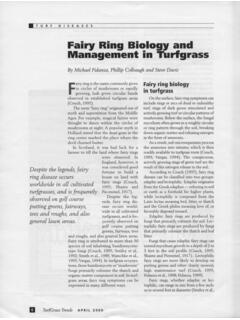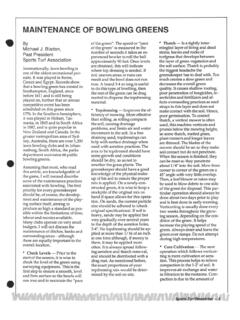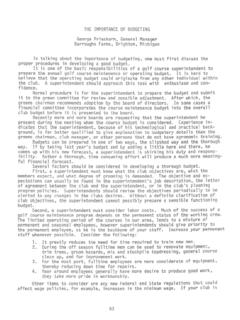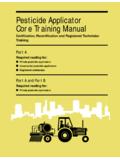Transcription of The African e-Journals Project has digitized full text …
1 The African e-Journals Project has digitized full text of articles of eleven social science and humanities journals. This item is from the digital archive maintained by michigan State University Library. Find more at: Available through a partnership with Scroll down to read the article. Zambezia (1992), XK (il).RESEARCH REPORTCLASSIFICATION OF JOBS INTO LEVELS OF WORK:FOUR RELIABILITY STUDIESJOSEPHINE JORDAN, COLLETTE MILLS, THEODORE MOYO,CHANDRA KESHAV and JOSHUA NDOZIYAD epartment of Pyschology, University of ZimbabweElliot Jaques (1956, 1961, 1967, 1968, 1970, 1975, 1978, 1982, 1986, 1988)proposed that work is naturally stratified into seven layers defined bytheir time span of discretion. Time span of discretion is the length of timebetween the allocation of an assignment and its review (Evans, 1979). Atlevel 1, the time span of discretion is three months or less; at level 7 it is 50years or more.
2 In the intermediate steps, time span of discretion increasesexponentially: 1 year, 2 years, 5 years, 10 years and 20 Southern Africa the concept of layers of management is widelyaccepted and is seen in both popular methods of job evaluation: thePaterson (Paterson, 1972a and 1972b) and the Castellion (Jordan, 1989).The Paterson system analyses the decision-making components of workand sorts jobs into six major groups. At the top of the hierarchy is policymaking. This is followed by programming decisions, then interpretivedecisions, choice of processes, responsibility for part of a process andperformance of job elements. These levels correspond to top management,senior management, middle management, junior management and skilledpositions, semi-skilled positions and unskilled Castellion system, which was developed by Cortis (Biesheuval,1977) for South African Breweries, is a point-rating system according to sixfactors: decision making, pressure of work, controls and checks,consequences of error, education and experience.
3 Though all six factorsare rated and the final job rating is an aggregate of all six evaluations, thedominant factor is decision making. The decision-making scale rangesfrom simple decisions, through pragmatic decisions to tactical decisionsand strategic relationship of the Paterson and Castellion systems to each otheris well known. The earliest conversion chart was presented by Paterson(1972a). The chart is so common that it is known by rote by mostpractitioners. Castellion grades 16 to 15 correspond to Paterson Band A;Castellion grades 14 to 11 correspond to Paterson Band B; Castelliongrades 10 to 7 to Paterson Band C; Castellion grades 6 and 5 to PatersonBand D; Castellion grades 4 and 3 to Paterson Band E; and Castelliongrades 2 and 1 to Paterson Band F, in ascending order from unskilled totop management relationship of both systems to the Jaques system is less wellknown but is amply described by Paterson (1972a) and by Biesheuval139140 CLASSIFICATION OF JOBS INTO LEVELS OF WORK(1977).
4 In all three systems, as seniority increases so does the level ofdecision making. In the Paterson system the decision is graded by thenumber and difficulty of constituent parts of a decision cycle. In theJaques system, the longer time span, that is, the longer period betweenassignment and review, permits decisions with more constituent Castellion system refers explicitly to decisions involving multiplecomponents. Empirical evidence of the links between the systems wasprovided by Cortis (in Paterson, 1972a). Cortis confirmed that there isperfect rank correlation between the Castellion grades and time span ofdiscretion. Table I compares the three systems a further development, Stamp (1978,1981,1986,1988,1989a, 1989b,1989c and Baker and Stamp, 1990) has used the Jaques grades as thefoundation for the assessment of management potential.
5 A key componentin the assessment procedure is the grading of work which is performed bythe manager at the time of the assessment. This grading takes place usingthe Jaques report details four studies, each of which evaluates how reliablyjobs are allocated to levels of work. The first study reviews the reliabilityof Paterson grades; the second and third studies explore the reliability ofCastellion grades; and the fourth examines the reliability of the Stamp/Jaques ONE: RELIABILITY OF PATERSON GRADINGSFour panels of five social studies students graded six job descriptionswhich had been prepared professionally and had been graded in a previousexercise. Two panels made no errors at all; one panel made one error; theremaining panel made two errors. A binomial test (Siegel, 1956) rejectsthis outcome or a more accurate outcome occurring through chance orguessing (p < 0,001).
6 'STUDY TWO: RELIABILITY OF CASTELLION GRADINGSE ighteen jobs in a city firm were evaluated by Josephine Jordan. In onlyten cases did the evaluations concur with evaluations of the jobs made bythe firm's own evaluation committee. This result is consistent withguessing,2 with probability under Ho of 0, THREE: RELIABILITY OF CASTELLION GRADINGSTo double-check the finding in study two, study one was extended toinclude the Castellion system. The job descriptions in the previous study1 Ho: p = 0,33; that is, there is a one-in-three probability of guessing a correct grade. Theprobability of occurrence under Ho of the observed values or more extreme values wascalculated for each panel using the formulas given in 4,2 in Siegel (1956). The probability offour panels achieving this result or more accurate results under Ho was obtained using themultiplicative See fn.
7 JORDAN ICOMPARISON OF THE WORK LEVELS PROPOSED BY JAQUES,PATERSON AND CASTELLIONJ aquesLevelIIIIIIIVVVIVIITime spanof discretion3 months1 year2 years5 years10 years20 years50 yearsPatersonGradeAB lowerB upperC lowerC upperD lowerD upperE lowerE upperF lowerF upperDecisonmakingPrescribeddecisionsAut omaticdecisionsCo-ordinatingautomaticdec isionsRoutinedecisionsCo-ordinatingrouti nedecisionsInterpretativedecisionsCo-ord inatinginterpretativedecisionsProgrammin gdecisionsCo-ordinatingprogrammingdecisi onsPolicydecisionsCo-ordinatingpolicydec isionsCastellionGrade1615141312111098765 4321 Decision-making factorSimpledecisionsPragmaticdecisionsT acticaldecisionsStrategicdecisions142 CLASSIFICATION OF JOBS INTO LEVELS OF WORK were regraded by the same students using the Castellion method. Twopanels made no errors; one panel made two errors; and the last panelmade four errors.
8 The probability of this number of errors or fewer errorsoccurring through guessing (p < 0,001) lies in the rejection region (Siegel,1956).3 STUDY FOUR: RELIABILITY OF STAMP/JAQUES GRADINGSOF CURRENT WORK LEVELSS ixteen students were each interviewed by two psychologists to establishthe highest level of work employed by them in any domain, for example,their studies, sport, vacational work, extramural activities, and so on. Thepsychologists agreed in 13 cases. The outcome of three or fewer errorsrejects the null hypothesis of chance classification (p > 0,011).4 SUMMARYThe empirical results present a favourable picture of the Paterson andStamp/Jaques classifications. In study one, students classified jobs on thePaterson system with sufficiently few errors to reject the null hypothesisof guessing. In study four, two psychologists assessed students' currentlevel of work and agreed in 13 cases out of 16.
9 Both schema are sufficientlyrobust to support consistent gradings by different Castellion system did not fare as well. The independent regradingof eighteen jobs in a city firm failed to reject the null hypothesis ofguessing and the students in study three made more errors than they didwith the Paterson system in study one. The fine gradations in the Castellionsystem appear to be more difficult to assess information revealed by post hoc analysis of the ratingerrors suggests that two issues are important to the reliability of jobsgrading. It has been well established that group decision making issometimes of a higher quality than individual decision making but, ifgroup dynamics are mismanaged, a group may make very bad four panels illustrate this social psychological result. The two panelsthat made no errors were the same panels in both the Paterson andCastellion studies.
10 The panel that made the most errors on the Patersonstudy also made the most errors on the Castellion. The number of errorsthis group made was unacceptably high (2/6; 4/6).In the studies with single raters, disparities in the information baseemerged as the main source of errors. In study two, in all eight jobs inwhich the independent rater disagreed with the committee, subsequentinvestigation revealed that the committee had had access to informationnot used by the independent rater. In study four, in all of the three cases in3 See fa. 1.* Ho: p = 0,50. University students are unlikely to perform above level 2 (see Stamp, 1988).The task was therefore to rate students at level 1 or at level 2. There are two opportunities forthe psychologists to agree (1,1; and 2,2) and two opportunities for the psychologists todisagree (1,2; and 2,1).















